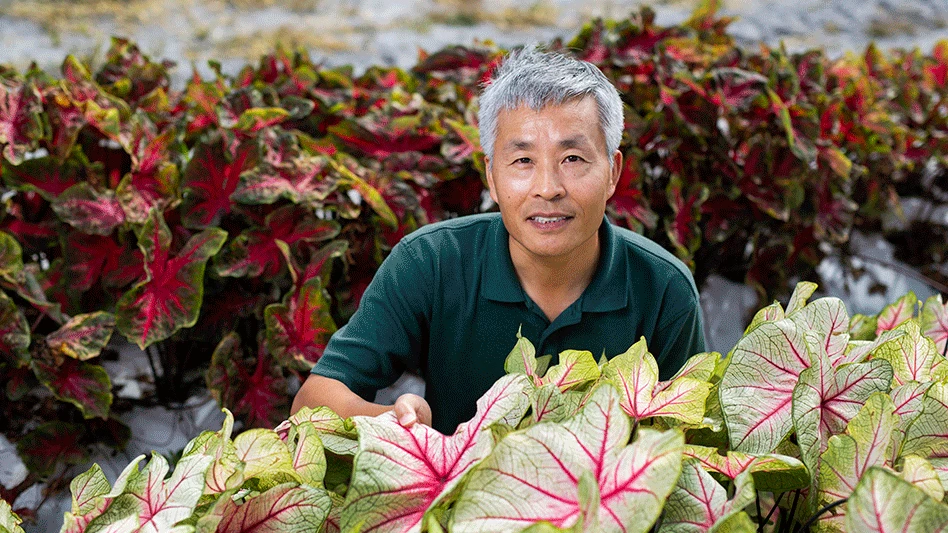

The Sunshine State serves as the sole source of caladium bulbs for the world, and since 1976, University of Florida’s Institute of Food and Agricultural Sciences researchers have been breeding varieties of this ornamental. Researcher and breeder Zhanao Deng has developed 34 caladium varieties during his 20-year UF/IFAS career, including ‘Royal Flush’, ‘Tapestry’, ‘Fiesta’, ‘Sizzle’ and ‘Lava Glow’.
‘Lava Glow’ is his latest selection. According to Deng, it grows well in containers or in landscapes, and does well in sun or shade.
“‘Lava Glow’, with bright red to reddish-purple leaves, can further enrich the plant palette for caladium growers, nurseries, landscapers and gardeners. It’s an important addition to the red, fancy-leaved caladium variety group,” he says.
Deng spends countless hours pairing the right parent plants to develop caladiums that nurseries and consumers will want.
“As a plant breeder, I am passionate about developing new cultivars that can satisfy needs of the environmental horticulture industry and consumers,” he says. “Caladiums can rival many flowers with their colorful, attractive leaves. They are easy to grow, and their color shows well for many months. That’s one reason so many people love caladiums, either in pots or the garden.”
Caladiums grow particularly well in Highlands County — about 60 miles south of Lakeland, in the heart of Florida. Deng calls the Lake Placid-Sebring area a “sweet spot” for producing caladiums. That’s because it has many months of frost-free weather, plenty of rain, fertile muck or organic soil.
Terri Bates, owner of Bates Sons & Daughters in Lake Placid, Florida, has relied on UFL breeding for many years.
“We grow 12 varieties developed by Dr. Deng, and they are a huge asset to our business as well as the landscape/retail garden center industry,” Bates says.
According to Deng, theirs is the only major organized caladium breeding program in the world to date. The program’s main objectives were to develop new cultivars that: can produce many bright colorful leaves and a high yield of good quality tubers; and have short, sturdy petioles and multi-eyed tubers that can result in increased early leaf production and improved leaf display. Additional goals of this program are to improve the aesthetic values and performance of caladium plants in containers and landscapes; to eliminate the costly labor associated with tuber de-eyeing; and to improve tuber and plant productivity and profitability.

Explore the March 2023 Issue
Check out more from this issue and find your next story to read.
Latest from Greenhouse Management
- 2025 Proven Winners Horticulture Scholarship applications now open
- How to improve inventory and shipping management in the greenhouse
- Leading Women of Horticulture: Anna Ball, Ball Hort, and Terri McEnaney, Bailey Nurseries
- GM CEA HERB Part 2: A guide to increasing the sowing density of culinary herbs
- GM CEA HERB Part 1: Best practices for producing culinary herbs in controlled environments
- USDA fires experts on invasive pests, including Asian citrus psyllid, chilli thrips
- CEA Alliance celebrates bipartisan introduction of Supporting Innovation in Agriculture Act
- Dümmen Orange North America celebrating 25th anniversary in 2025





